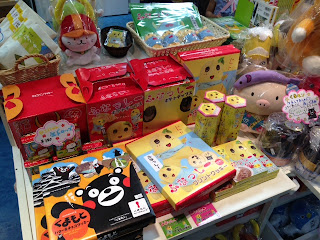What is "yuru kyara" ? It is a character or mascot which represents a local area or town. Jun Miura, a Japanese essayist and comic artist, devised the idea of yuru kyara. "Yuru kyara" comes from the Japanese word "yurui" and the English word "character". A literal translation of "yurui" means loose, slack, lax and gently. But we also use "yurui" to mean at ease, in a relaxed mood, or soft, cute, and cuddly. I don't know how many yuru kyara there are in Japan. But last year at the contest "the grand prize of yuru kyara", 865 yuru kyara were entered. This contest decides the the No.1 yuru kyara.
My favorite yuru kyara is "Kumamon". He is a lovely black bear.
He is a mascot representing the Kumamoto prefecture in Kyushu area. He was the champion of the grand prize of yuru kyara 2011. He has not only a cute face, but also a big economic impact. Last year, the total sales of his product has drawn was 29.3 billion yen. One crucial difference between kumamon and other mascots is the usage fee. If a product is related to the promotion of Kumamoto prefecture, we can use Kumamon to merchandise it for free. Now, you can see many kinds of kumamon goods all over Japan.
Even so, why is a character or mascot so popular in Japan? In my opinion, that is because Japanese manga are very sophisticated. There are many artistic scenes and well-made stories. I also enjoyed comics when I was a child. Sometimes I longed for the heroine of the cartoon.
In Japan, there are a lot of comics for adults as well as children. Japanese adults are often reading manga at a convenience store. It is an everyday occurrence. Manga culture might be a factor of yuru kyara boom which add to the mascot's beauty. I want you to enjoy Japanese manga and mascot culture. The photo below is a girl's Japanese manga that is translated into French.
I think that manga and mascot cultures are important tools for understanding Japanese culture.
He is a mascot representing the Kumamoto prefecture in Kyushu area. He was the champion of the grand prize of yuru kyara 2011. He has not only a cute face, but also a big economic impact. Last year, the total sales of his product has drawn was 29.3 billion yen. One crucial difference between kumamon and other mascots is the usage fee. If a product is related to the promotion of Kumamoto prefecture, we can use Kumamon to merchandise it for free. Now, you can see many kinds of kumamon goods all over Japan.
Even so, why is a character or mascot so popular in Japan? In my opinion, that is because Japanese manga are very sophisticated. There are many artistic scenes and well-made stories. I also enjoyed comics when I was a child. Sometimes I longed for the heroine of the cartoon.
In Japan, there are a lot of comics for adults as well as children. Japanese adults are often reading manga at a convenience store. It is an everyday occurrence. Manga culture might be a factor of yuru kyara boom which add to the mascot's beauty. I want you to enjoy Japanese manga and mascot culture. The photo below is a girl's Japanese manga that is translated into French.
I think that manga and mascot cultures are important tools for understanding Japanese culture.







0 件のコメント:
コメントを投稿